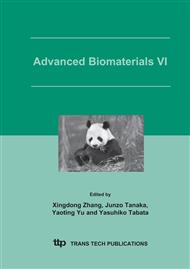p.343
p.347
p.351
p.355
p.359
p.363
p.367
p.373
p.377
Comparison in In Vitro Evaluation of Wollastonite and Dicalcium Silicate Coatings
Abstract:
In-vitro evaluation of plasma sprayed wollastonite and dicalcium silicate coatings was carried out by SBF soaking test and osteoblasts seeding test. Apatite layers were formed on the surfaces of the two coatings indicative of the excellent bioactivity. The formation rate of apatite is higher on dicalcium silicate than on wollastonite. The cause is believed to be the presence of orthosilicate species in the dicalcium silicate coating promoting easier leaching by exchanging H3O+ ions from the solution with calcium ions concentrated in the orthosilicate positions. At the same time, loss of soluble silicon occurs, and it is supposed to enhance the repolymerization of the silica gel layer and provide the active sites for the nucleation of apatite. The outcome is that apatite forms faster on dicalcium silicate than on wollastonite. The data obtained from the osteoblasts seeding test indicate that the wollastonite and dicalcium silicate coatings promote the proliferation of osteoblasts and possess excellent biocompatibility.
Info:
Periodical:
Pages:
359-362
Citation:
Online since:
June 2005
Authors:
Keywords:
Price:
Сopyright:
© 2005 Trans Tech Publications Ltd. All Rights Reserved
Share:
Citation:


